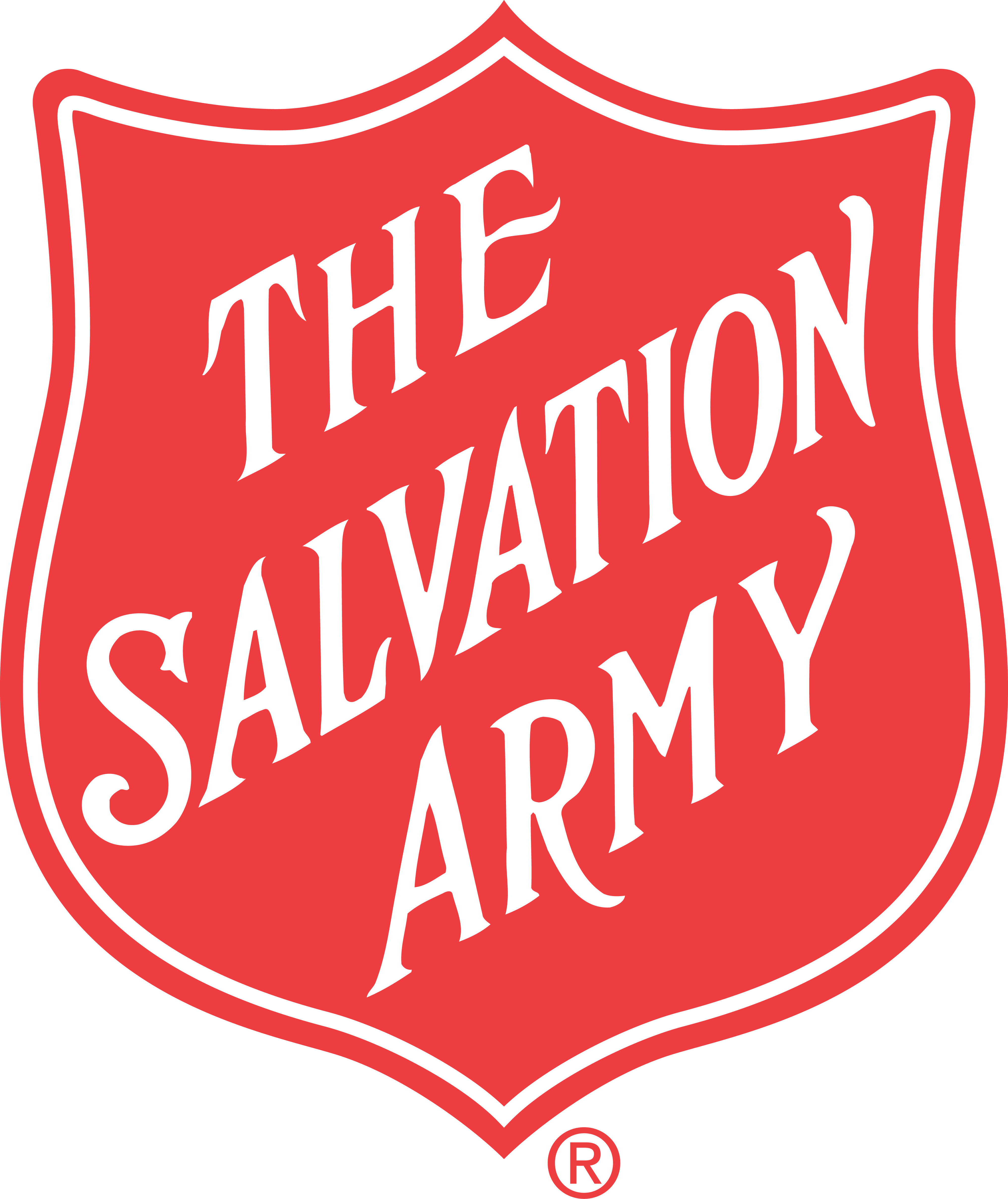Open Hearts and Cool Heads
by Warren L. Maye
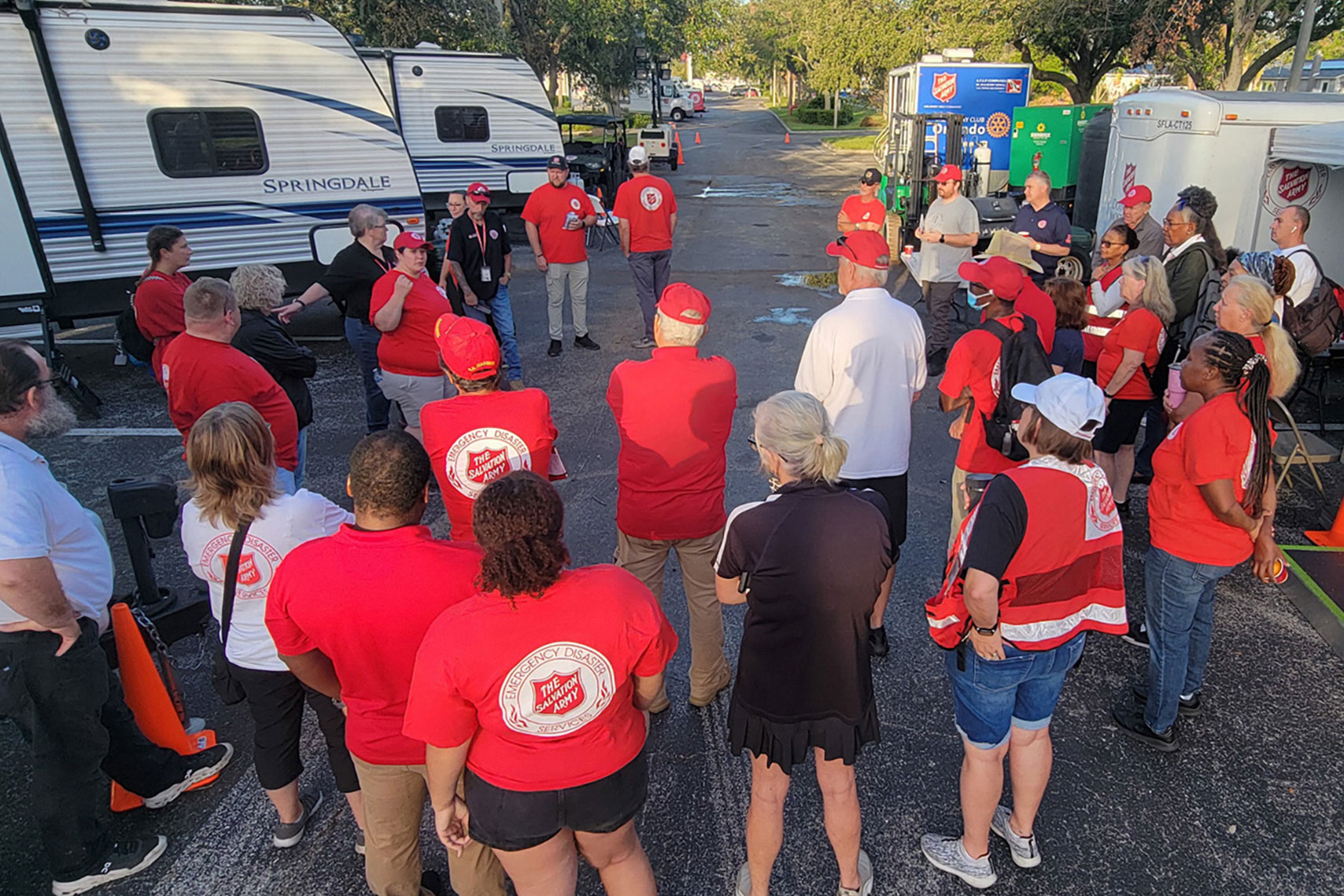
Salvation Army Emergency Disaster Services team members and volunteers stand in a circle for a morning briefing in a parking lot filled with trailers and response vehicles. The gathering takes place at the Salvation Army Social Services Center in Clearwater, Florida, following Hurricane Milton in October 2024. Most participants wear red EDS shirts or vests, symbolizing their active service in disaster relief efforts.
A recent plane crash in a busy Philadelphia neighborhood lit up the night sky with flames and scattered debris over the crowded streets. Tragically, the medevac flight carried a child, her mother, and a medical team along with the crew, who all perished. One person on the ground was killed and dozens injured. Videos from the scene went viral. The incident came during a period filled with disasters happening across the country—aircraft crashes, hurricanes and tornadoes, flooding, and wildfires all made headlines.
In every one of these situations, personnel from The Salvation Army’s Emergency Disaster Services (EDS) jumped right in to provide crucial support along with emotional and spiritual care for survivors, first responders, and the Army’s own caregivers when needed.
Chris Farrand, territorial training and volunteer engagement coordinator, has worked for EDS in The Salvation Army Eastern Territory for almost 17 years. While he’s never been pessimistic about these events, he’s noticed that such disasters are occurring with increasing frequency and intensity amid climate change.
“My job has gotten much busier,” says Farrand, who in his younger years trained as a bush pilot for missionaries in remote areas of the world. Major hurricanes or disasters would happen once every two or three years in his experience; now multiple incidents come within shorter intervals in between.
The Salvation Army and other agencies and nongovernmental organizations have mobilized resources to address emerging needs through financial support, personnel deployment, equipment provision, and other forms of assistance. For Farrand, a graduate of Gordon-Conwell Theological Seminary (M.Div.) and Moody Bible Institute (B.A.) who’s also served as a group home manager, a significant concern arising from these tragedies is emotional trauma. “Often it’s easier to repair external damage than to heal internal wounds,” he says. After such events, individuals frequently find it difficult to express their pain and loss.
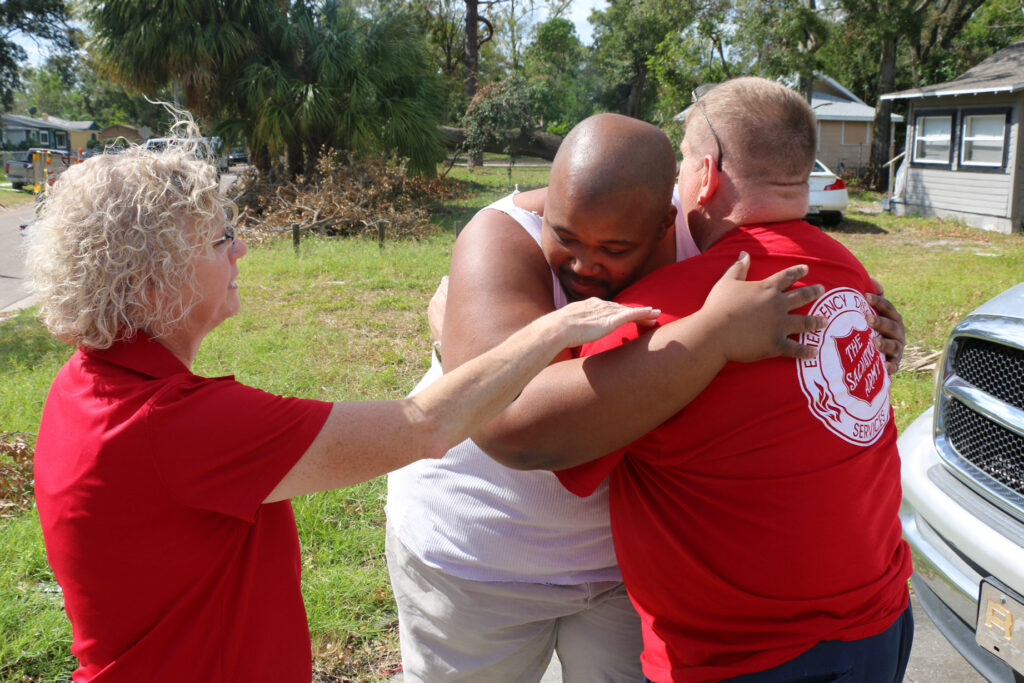
Major Candy Fritsch and Captain Edward McMillen from the Northeast Ohio Division comfort a man named Shelby; ruined belongings were piled everywhere. Providing spiritual and emotional support, food, and other basic needs is the foundation of Salvation Army Emergency Disaster Services.
Emotional and psychological impacts may not surface until long after media coverage fades. So EDS personnel offer practical aid and supplies for those affected by tragedy as well as long-term emotional and spiritual care through the ministry of presence—and the caregivers themselves often need care to cope with what they witness.
Many individuals have benefited from The Salvation Army’s comprehensive support system during their darkest moments. In a crisis, EDS workers like Farrand must be able to adapt swiftly to address complex needs with expertise and empathy.
“Emotional and spiritual care (ESC) is essential during crises. It emphasizes the importance of compassionate presence, effective communication, community connections, and continuous training resources. By integrating these practices into our daily lives, we can empower those around us and face challenges together with empathy.”
—Chris Farrand, Territorial Training and Volunteer Engagement Coordinator
On a mission in Clearwater
Bob Myers III is the territorial disaster services director for The Salvation Army’s Eastern Territory. Best known by family and friends as “Bobby,” he was just a kid when he followed his dad, Bob Myers Jr., into a Salvation Army canteen, or service truck, many years ago. Today, his passion for EDS work continues. He vividly describes a disaster response effort last year following Hurricane Milton (October), which struck an area already affected by Hurricane Helene (September) in the Southeastern United States, especially Florida and Georgia.
“The primary mission involved feeding people, particularly where many residents were still without power,” Myers says. “We had 11 or 12 canteens, mostly servicing Pinellas County, which is the area where St. Petersburg and Clearwater are located. The whole area was without power when we first arrived, with few locations outside the main corridor having electricity.”
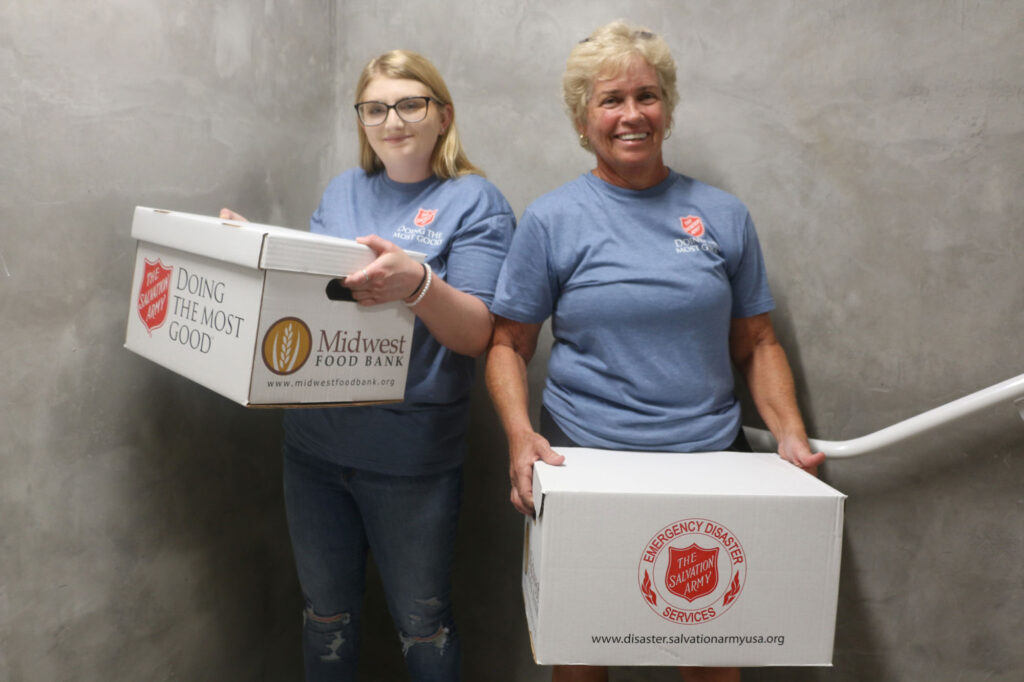
Sydney Blackmore and her mother, Kim Blackmore, are two of the volunteers in Clearwater, Fla., who helped carry 80 food boxes and 60 cases of water up the stairs to residents of a 12-story building.
When the team left after two weeks, there were still a couple of pockets in the St. Pete area without power.
“This disaster was unique,” he says, “because they had already been hit hard by storm surge from Hurricane Helene two or three weeks earlier and were just starting to recover when Hurricane Milton struck.”
Local authorities had managed relief and cleanup operations during Helene. Myers and his colleagues arrived two days after Milton hit and supported relief efforts in the aftermath. Many residents had already cleaned out their houses and placed damaged possessions on their front lawns after Hurricane Helene.
Downed trees and wires and flooded apartment complexes presented logistical challenges, but Myers’ team distributed nearly 45,000 meals over two weeks while also addressing the emotional needs of the people they encountered. Myers saw resilience in the community but also a great need for spiritual support after back-to-back storms.
“Spiritually speaking, it’s really important to provide not just physical help but also to recognize the emotional issues that come up,” Myers says. “We got a lot of positive vibes from people affected, showing their strength even when things got rough. You can often see this in the little acts of kindness that people share with each other during hard moments. If we join forces, we can spread hope in our communities as they work on bouncing back.”
Navigating the needs
Hurricane Milton represented Kathryn “Katie” Perrett’s first EDS response in the South, but as a veteran of the U.S. Navy, she was no stranger to this kind of work. On the USS Iwo Jima, an amphibious assault ship then based out of Virginia, she’d held a specialized rating as boatswain’s mate—a jack-of-all-trades, skilled at seamanship, deck maintenance, navigation, and supervising ship work parties and small boat operations.
On Myers’ EDS team, she served as the operations chief in heavily flooded urban areas like Hillsborough and Pasco counties. Perrett assessed damage to trailer parks, coordinated relief efforts, and ensured that supplies like food and drinks were distributed effectively.
“My goal each day,” she says, “involved directing teams toward specific locations and informing them about supplies they would distribute—whether food or cleanup kits—while ensuring crucial hydration needs were met. I saw some of the heavily impacted areas that were still very much flooded. Hopefully, those folks had planned ahead with (enough) food for days, waiting for the situation to improve.”
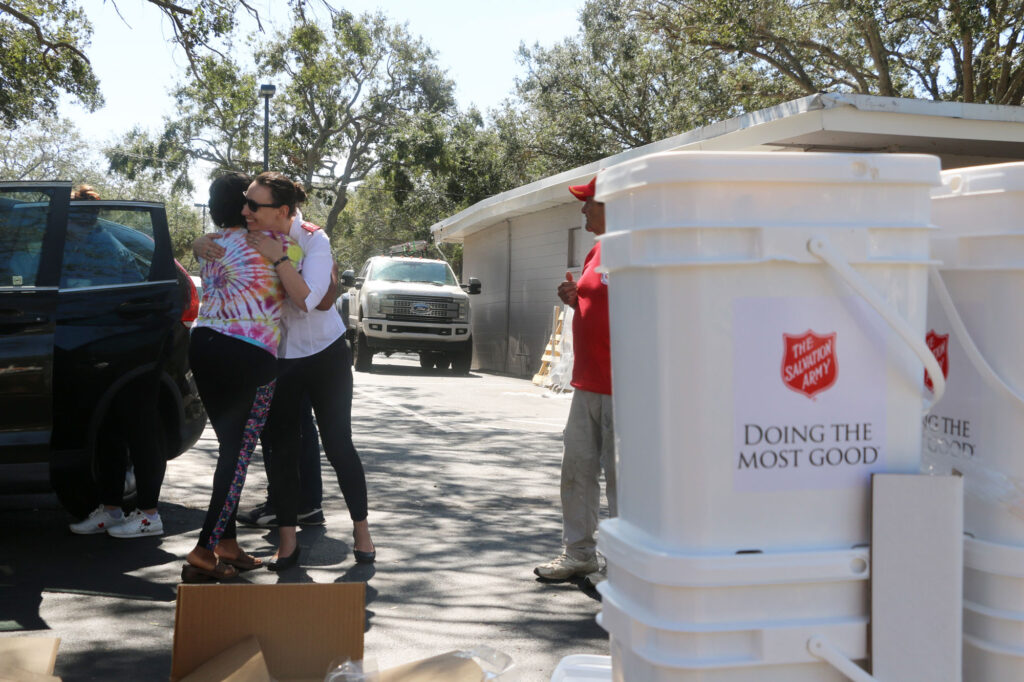
Captain Jessica Welch, St. Petersburg corps officer, hugs someone who came to pick up hot meals, snacks, cleanup kits, and water.
Her naval training made her ready for anything. In EDS work, Perrett says, “people just have to have flexibility and a heart for service. Every day was a little bit different. Sometimes I would keep the teams together, or sometimes I would split people up. Someone could have been in a location for a week straight, and then I would put them in a different location every day.”
Despite the rigorous work, emotional connections formed between Perrett, volunteers, and recipients of aid. She too saw the importance of spiritual care for both survivors and responders, even as she sought to deploy her team efficiently into areas with enormous needs.
“Everyone has different strengths,” Perrett says. “I had to assess everyone—their skill set and their character and who they were, what they could bring to the table. This team was really great. When I said, ‘I need you to do this tomorrow; I know it’s different than what you’ve been doing,’ they said, ‘Whatever you need.’ If you want to do this work, if you want to help people in this capacity, we need people to go who have the mindset that you must be flexible.”
Bearing the burden
“I’d rather sit with people when they’re rejoicing, but I have a passion for people in crisis,” says Major Barbara George, The Salvation Army’s divisional director of Women’s Ministries and Officer Development for Northeast Ohio. “Not like a social work passion—it’s more of a sitting and suffering with people that comes naturally to me.” Her deep commitment to helping the poor and downtrodden brings to mind George Bernard Shaw’s fictional Salvation Army officer in his famous play Major Barbara. Indeed, Major Barbara George is the real deal.
“For over 30 years as an officer,” George says, “I’ve always made myself available in disaster work because it kind of scratches an itch or ticks a box or whatever you want to call it, for me.”
When Myers called to ask if she would deploy to Clearwater as a divisional leader, George wanted to make sure she’d be of the best use to the Army and the people it serves.
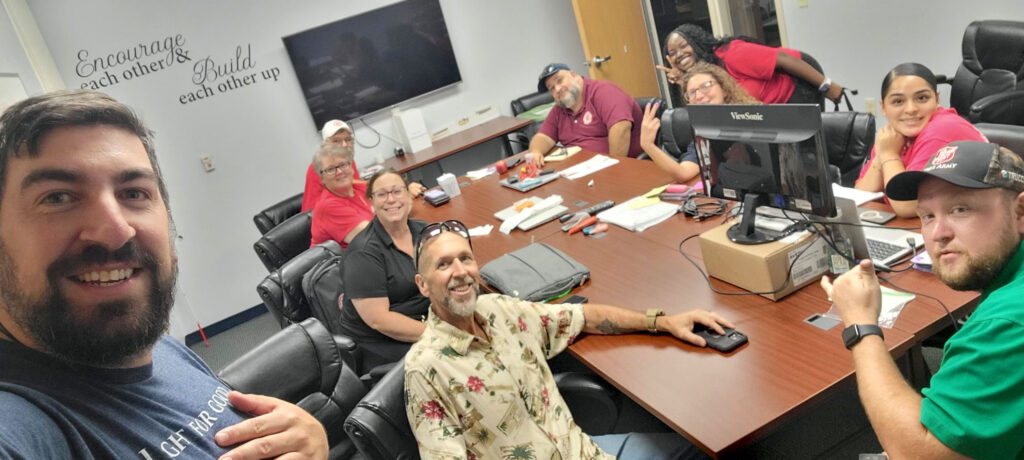
The Incident Management Team (clockwise from left) in Clearwater: Michael Baldelli, Stan Carr, Katie Perrett, Major Barbara George, Major Fred Clarke, Bobby Myers, Rebecca Louis, Deborah Pollock, Jenny Valverde, and Captain Dustin Fitch.
“After discussing it with my husband, we decided, why not? It’s what I love, and I could set an example for other leaders that, yes, you can make time for important things. I knew God would bless me more than any blessing I’d give,” George says. “Every deployment is different. I’ve done quite a few national-level deployments and consider myself somewhat of a veteran. The biggest challenge usually is figuring out what I’m going to encounter when I get there—especially since we were the first team in the Clearwater area.”
Local authorities had been coordinating the response but couldn’t provide any good intel on the scope of the damage they might face.
“My role was to be part of the leadership team, and my title would be emotional and spiritual care chief. I was to coordinate any volunteers who were sent to us to do specifically emotional and spiritual care. So I had two tasks: one, visit people in their homes and make sure they were OK and get information back. And my second task was to approach the local corps officer to say, ‘I know there’s a lot of retired officers, corps people, staff, and you who have been impacted. How can I assist in any way?’”
Helping people after a destructive storm takes an emotional toll. George remembers a distressing encounter with one elderly woman who had a very argumentative attitude. She was reluctant to accept any help from a stranger knocking on her door, despite her dire situation. Besides the flooding and the heat causing mold to grow inside her home, the woman had only six containers of drinking water left alongside empty jars once filled with peanut butter. Her rooms were defined by ragged curtains instead of solid walls.
“I was determined to kill her with kindness,” George says now with a smile. She gently asked the woman for the whereabouts of any family members, and as they talked, the woman gradually opened up and allowed glimpses into a life shaped through hardships endured over decades.
George also cared for the caregivers who returned each night to base camp—a group of RVs in a parking lot. She’d help them unpack the sights, sounds, smells, thoughts, and emotions experienced during the day so they could wind down and sleep through the night.
“We had probably 40 people in the base camp,” George says. “The first night, I had eight volunteers come and I played praise and worship music. I’d read some scripture from Psalms. Then I would open the floor and say, ‘OK, where did you see God today?’ or ‘What’s a challenge that you faced today that we all can support you with?’ And I tell you, there were some beautiful stories of God moments and of God encounters that these volunteers had with people who were coming either for food or waiting in the line for (federal assistance). Our people would just weave their way in and out, just having conversation, offering prayer. People were so receptive to prayer. It was amazing to me.”
Through these shared moments, George says, the realization dawned upon all the volunteers that serving others ultimately leads to discovering joy that may lie hidden beneath layers of grief and sorrow when calamity strikes. It is wrapped tightly around souls yearning for God-inspired healing and restoration.

